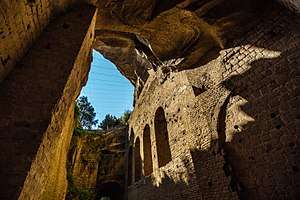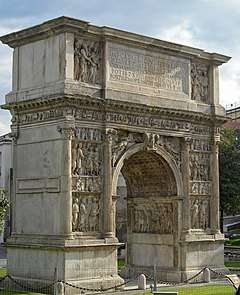Cumae
|
Κύμη / Κύμαι / Κύμα Cuma | |
|
The acropolis of Cumae seen from the lower city | |
 Shown within Italy | |
| Location | Cuma, Province of Naples, Campania, Italy |
|---|---|
| Region | Magna Graecia |
| Coordinates | 40°50′55″N 14°3′13″E / 40.84861°N 14.05361°ECoordinates: 40°50′55″N 14°3′13″E / 40.84861°N 14.05361°E |
| Type | Settlement |
| History | |
| Builder | Colonists from Euboea |
| Founded | 8th century BC |
| Abandoned | 1207 AD |
| Periods | Archaic Greek to High Medieval |
| Associated with | Cumaean Sibyl, Gaius Blossius |
| Events | Battle of Cumae |
| Site notes | |
| Management | Direzione Regionale per i Beni Culturali e Paesaggistici della Campania |
| Website | Sito Archeologico di Cuma (in Italian) |
Cumae (Ancient Greek: Κύμη, translit. (Kumē) or Κύμαι (Kumai) or Κύμα (Kuma);[1] Italian: Cuma) was the first ancient Greek colony on the mainland of Italy, founded by settlers from Euboea in the 8th century BC and soon becoming one of the strongest colonies. It later became a rich Roman city, the remains of which lie near the modern village of Cuma, a frazione of the comune Bacoli in the Province of Naples, Campania, Italy.
Early history
The settlement is believed to have been founded in the 8th century BC by Greeks from the cities of Eretria and Chalcis in Euboea and the oldest archaeological finds date to 725-720 BC.[2] They were already established at nearby Pithecusae (modern Ischia)[3] and were led to Cumae by the joint oecists (founders): Megasthenes of Chalcis and Hippocles of Cyme.[4]
The Greeks occupied the site of earlier dwellings of indigenous, Iron Age peoples whose memory was preserved as cave-dwellers named Cimmerians, among whom there was already an oracular tradition.[5]
The colony was located on particularly fertile ground on the edge of the Campanian plain. While continuing their maritime and commercial traditions, the settlers of Cumae strengthened their political and economic power by exploitation of the land and extended their territory at the expense of neighbouring peoples.
The colony thrived and in the 8th century it was strong enough to send Perieres to found Zancle in Sicily, and another group to found Triteia in Achaea, Pausanias was told.[6] Cuma established its dominance over almost the entire Campanian coast up to Punta Campanella over the 7th and 6th centuries BC, gaining sway over Puteoli and Misenum and founding Neapolis in 470 BC. Cumae's first brief contemporary mention in written history is in Thucydides.
The colony spread Greek culture in Italy and introduced the Euboean alphabet, a dialect of Greek and a variant of which was adapted and modified by the Etruscans and then by the Romans and became the Latin alphabet still used worldwide today.
The growing power of the Cumaean Greeks led many indigenous tribes of the region to organise against them, notably the Dauni and Aurunci with the leadership of the Capuan Etruscans. This coalition was defeated by the Cumaeans in 524 BC under the direction of Aristodemus, called Malacus, a successful man of the people who overthrew the aristocratic faction, became a tyrant himself and was then assassinated.[7]
The glorious victories of the colony had increased its prestige, so much so that according to Diodorus Siculus, it was usual to associate the whole region of the Phlegraean Fields with Cumaean territory.
Contact between the Romans and the Cumaeans is recorded during the reign of Aristodemus. Livy states that immediately prior to the war between Rome and Clusium, the Roman senate sent agents to Cumae to purchase grain in anticipation of a siege of Rome.[8] Also Lucius Tarquinius Superbus, the last legendary King of Rome, lived his life in exile with Aristodemus at Cumae after the Battle of Lake Regillus and died there in 495 BC.[9] Livy records that Aristodemus became the heir of Tarquinius, and in 492 when Roman envoys travelled to Cumae to purchase grain, Aristodemus seized the envoys' vessels on account of the property of Tarquinius which had been seized at the time of Tarquinius' exile.[10]
Also during the reign of Aristodemus, the Cumaean army assisted the Latin city of Aricia to defeat the Etruscan forces of Clusium.
The combined fleets of Cumae and Syracuse (on Sicily) defeated the Etruscans at the Battle of Cumae in 474 BC.
The temple of Apollo sent the revered Sibylline Books to Rome in the 5th c. BC. Also Rome obtained its priestesses who administered the important cult of Ceres from the temple of Demeter in Cumae.
Oscan and Roman Cumae

-6.jpg)
_01.jpg)
The Greek period at Cumae came to an end in 421 BC, when the Oscans broke down the walls and took the city, ravaging the countryside. Some survivors fled to Neapolis.[11] Cumae came under Roman rule with Capua and in 338 BC was granted partial citizenship, a civitas sine suffragio. In the Second Punic War, in spite of temptations to revolt from Roman authority,[12] Cumae withstood Hannibal's siege, under the leadership of Tib. Sempronius Gracchus.[13]
During the civil wars Cumae was one of the strongholds that Octavian used to defend against Sextus Pompey.
The city prospered in the Roman period from the 1st c. BC along with all the cities of Campania and especially the bay of Naples as it became a desirable area for wealthy Romans who built large villas along the coast. Under Augustus extensive public building works and roads were begun and in or near Cumae several road tunnels were dug: one through the Monte di Cumae linking the forum with the port, the Grotta di Cocceio 1 km long to Lake Averno and a third, the "Crypta Romana", 180m long between Lake Lucrino and Lake Averno. The temples of Apollo and Demeter were restored.
The proximity to Puteoli which was commercial port of Rome and to Misenum, the naval fleet base, also helped the region to prosper.
Another very important innovation was the construction of the great Serino aqueduct, the Aqua Augusta supplying many of the cities in the area from about 20 BC. Domitian's via Domitiana provided an important highway to the via Appia and thence to Rome from 95 AD.
The early presence of Christianity in Cumae is shown by the 2nd-century AD work The Shepherd of Hermas, in which the author tells of a vision of a woman, identified with the church, who entrusts him with a text to read to the presbyters of the community in Cuma. At the end of the 4th century, the temple of Zeus at Cumae was transformed into a Christian basilica.
The first historically documented bishop of Cumae was Adeodatus, a member of a synod convoked by Pope Hilarius in Rome in 465. Another was Misenus, who was one of the two legates that Pope Felix III sent to Constantinople and who were imprisoned and forced to receive Communion with Patriarch Acacius of Constantinople in a celebration of the Divine Liturgy in which Peter Mongus and other Miaphysites were named in the diptychs, an event that led to the Acacian Schism. Misenus was excommunicated on his return but was later rehabilitated and took part as bishop of Cumae in two synods of Pope Symmachus. Pope Gregory the Great entrusted the administration of the diocese of Cumae to the bishop of Misenum. Later, both Misenum and Cumae ceased to be residential sees and the territory of Cumae became part of the diocese of Aversa after the destruction of Cumae in 1207.[14][15][16] Accordingly, Cumae is today listed by the Catholic Church as a titular see.[17]
Under Roman rule, so-called "quiet Cumae"[18] was peaceful until the disasters of the Gothic Wars (535–554), when it was repeatedly attacked, as the only fortified city in Campania aside from Neapolis: Belisarius took it in 536, Totila held it, and when Narses gained possession of Cumae, he found he had won the whole treasury of the Goths. In 1207, forces from Naples, acting for the boy-King of Sicily, destroyed the city and its walls, as the stronghold of a nest of bandits.
Monuments
The visible monuments include:
- temple of Diana
- Capitoline temple of Jupiter, Juno and Minerva (or "Zeus")
- temple of Isis
- temple of Demeter
- temple of Apollo
- The acropolis
- Arco Felice
- the forum
- Grotta di Cocceio
- Crypta Romana
In June 2018, a painted tomb discovered in Cumae which depicts a banquet scene, dates back to 2nd century B.C.[19]
Mythology
Cumae is perhaps most famous as the seat of the Cumaean Sibyl. Her sanctuary is now open to the public.
In Roman mythology, there is an entrance to the underworld located at Avernus, a crater lake near Cumae, and was the route Aeneas used to descend to the Underworld.
Diocese of Cuma(e)
- Not to be confused with the namesake Cuma (Aeolis) in Asia Minor
A bishopric was established around 450 AD. In 700 it gained territory from the suppressed Diocese of Miseno.
In 1207 it was suppressed itself, its territory being divided and merged into the Roman Catholic Diocese of Aversa and Roman Catholic Diocese of Pozzuoli.
Resident bishops
- Saint Massenzio (300? – ?)
- Rainaldo (1073? – 1078?)
- Giovanni (1134? – 1141?)
- Gregorio (1187? – ?)
- Leone (1207? – ?)
Titular see
In 1970, the diocese was nominally restored as a Latin titular see.
So far, it has had the following incumbent, of the lowest (episcopal) class with a single archiepscopal exception:
- Titular Bishop Louis-Marie-Joseph de Courrèges d’Ustou (1970.09.02 – 1970.12.10)
- Titular Archbishop Edoardo Pecoraio (1971.12.28 – 1986.08.09)
- Titular Bishop Julio María Elías Montoya, Friars Minor (O.F.M.), Apostolic Vicar of Apostolic Vicariate of El Beni (Bolivia) (1986.11.17 – ...).
Gallery
See also
Notes and references
- ↑ Perseus: Κύ̂μα
- ↑ Eusebius of Caesarea placed Cumae's Greek foundation at 1050 BC; modern archaeology has not detected the first settlers' graves, but fragments of Greek pottery ca 750-40 have been found by the city wall (Robin Lane Fox, Travelling Heroes in the Epic Age of Homer, 2008:140).
- ↑ Strabo, v.4.
- ↑ Lane Fox 2008:140 notes that whether the Euboeans were from the Ischian colony or freshly arrived is a moot question
- ↑ Strabo, v.5, noted in Elizabeth Hazelton Haight, "Cumae in Legend and History" The Classical Journal 13.8 (May 1918:565-578) p. 567.
- ↑ Pausanias, vii.22.6.
- ↑ Dionysius of Halicarnassus, vii.3; Plutarch tells the story of Xenocrite, the girl who roused the Cumaeans against Aristodemus, in De mulierum virturibus 26.
- ↑ Livy, Ab urbe condita, 2.9
- ↑ Livy, ii.21; Cicero, Tusculan Disputations iii.27.
- ↑ Livy, Ab urbe condita, 2:34
- ↑ Livy, iv.44; Diodorus Siculus, xii. 76.
- ↑ Livy, xxiii.35
- ↑ Livy, xxiii.35-37.
- ↑ Camillo Minieri Riccio, Cenni storici sulla distrutta città di Cuma, Napoli 1846, pp. 37–38
- ↑ Giuseppe Cappelletti, Le Chiese d'Italia dalla loro origine sino ai nostri giorni, vol. XIX, Venezia 1864, pp. 526–535
- ↑ Francesco Lanzoni, Le diocesi d'Italia dalle origini al principio del secolo VII (an. 604), vol. I, Faenza 1927, pp. 206–210
- ↑ Annuario Pontificio 2013 (Libreria Editrice Vaticana 2013 ISBN 978-88-209-9070-1), p. 877
- ↑ Juvenal, Satire III
- ↑ "Painted tomb discovered in Cumae (Italy) : A banquet frozen in time". CNRS. 25 September 2018.
External links
| Wikimedia Commons has media related to Cumae. |



